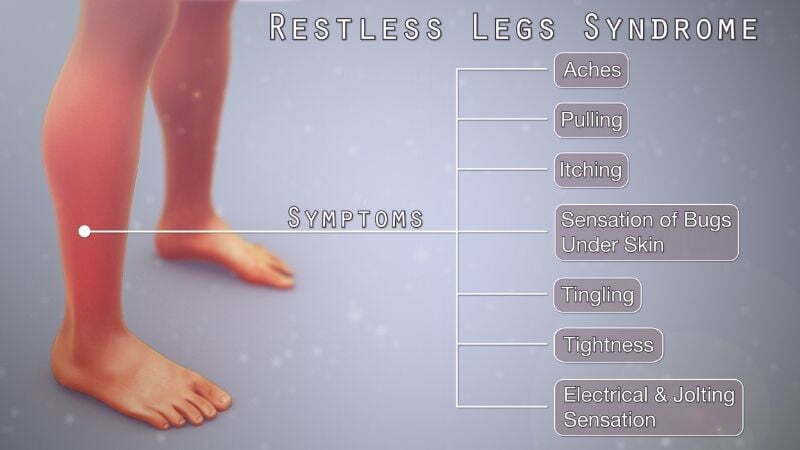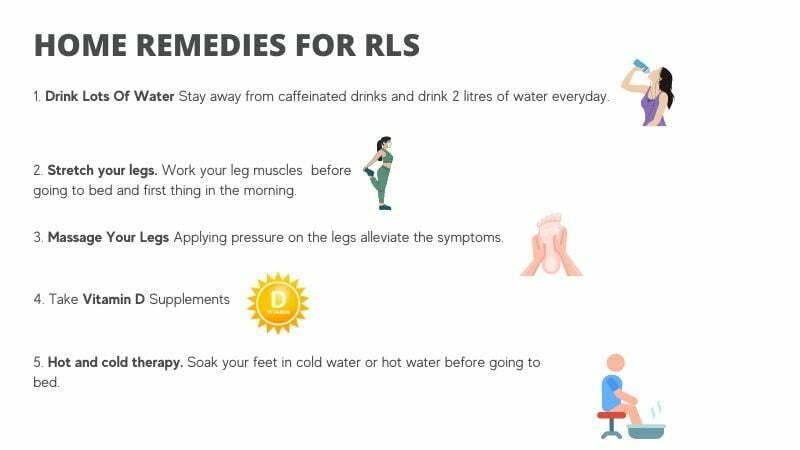What is restless leg syndrome? It is a syndrome marked by an almost insatiable desire to move one’s legs, usually at night. It is a neurological disorder.
RLS is a disorder in which you have an uncontrolled desire to move your legs, generally responding to an unpleasant sensation. It can be anything from a tingling sensation to crawling or tugging.
It usually happens when you’re seated or lying down in the evening or at night. Moving around briefly alleviates the uncomfortable feeling.
Causes of Restless Leg Syndrome
Restless Leg Syndrome (RLS) is a genetic condition passed down from one generation to the other. Apart from genetic predisposition, there are numerous medical problems associated with the development of Restless Leg Syndrome:
- Low levels of iron
- Stress
- Depression
- Diabetes
- Kidney Diseases
- Dialysis
- Peripheral neuropathy
- Rheumatoid Arthritis
- Parkinson’s disease.
All these medical problems can cause RLS or make the symptoms worse.
Patients with RLS who have a genetic link develop symptoms sooner in life (before 45) than individuals with RLS whose cause is different. RLS is more common in women than men.
Restless Leg Syndrome Symptoms
Depending on the age, RLS symptoms can vary from mild to severe. It may become worse as you get older. It’s a chronic illness with no cure but can be controlled with lifestyle changes and medication.

The primary symptom is a strong desire to move one’s legs. In addition, the following symptoms often accompany RLS:
- Sensations that begin after rest: The feeling usually starts after you’ve been lying or sitting for an extended period, such as in a car, plane, or movie theatre. The simplest activities, like going to a movie or sitting in the car, can seem like a task.
- Night-time leg twitching: RLS may be linked to a more common disorder known as periodic limb movement of sleep, which causes your legs to twitch and kick as you sleep, perhaps all night.
- Daytime Sleepiness: Daytime drowsiness can be caused by difficulties falling and staying asleep at night.
- Sleep Disruption: It takes longer to fall asleep because you need to move your limbs to reduce the ache. It might be tough to fall asleep and remain asleep at times.
- Bedtime Behaviour Problems: You may need to get out of bed to stretch your limbs to ease the discomfort. Your partner, too, can be affected by constant tossing and turning.
- Behaviour Changes: All the sleep deprivation and restlessness cause irritability, mood changes, and difficulty concentrating.
- Additional Symptoms: Consumption of alcohol and caffeine can trigger or intensify the symptoms, and also certain medications to treat depression, like antidepressants and anti allergies medication, can also amplify the problem.
When To See A Doctor and How RLS Is Diagnosed?
As it is a neurological disorder, there are no specific tests performed. Instead, the diagnosis is made based on the symptoms. The sensations might be difficult to describe at times.
For example, RLS sufferers seldom characterize their symptoms as muscular cramps or numbness. However, they regularly express a desire to move their legs.
It’s normal for symptoms to change in intensity. Symptoms may subside for a while before reappearing.
Based on the symptoms and to rule out any other conditions, the doctor can prescribe a series of tests, including blood work and physical and neurological exams.
As RLS is primarily a genetic condition, the doctor may evaluate a complete family history related to RLS. In addition, other sleep disorders, particularly obstructive sleep apnea, may be considered using an overnight sleep study.
Other than that, your healthcare practitioner will also inquire about any sleep issues you’ve had due to your symptoms, such as insomnia (difficulty falling or staying asleep).
Your healthcare practitioner will also ask about any problems with remaining awake during the day, as well as any other issues with behavior or work performance.
To confirm the diagnosis of RLS, a patient suffering from any symptoms will have to meet the following criteria:
- Urge or desire to move legs or arms.
- Uncomfortable or unpleasant sensations like itching, aching, tugging and crawling.
- If the symptoms begin or worsen during the period of rest or inactivity.
- If the symptoms are more severe during the evenings or at night.
- If the symptoms are relieved partially or entirely by stretching or walking.
Restless Leg Syndrome Treatment
The treatment depends on the severity of the symptoms. Non-drug treatments are prescribed first to manage RLS, especially if you have mild symptoms. Home remedies may also help in the reduction of some symptoms. However, it may take trial and error to discover the most effective solution.

The doctor may recommend the following lifestyle changes to manage the symptoms:
- Exercise regularly – to practice yoga and meditation
- Reduce the intake of caffeine and alcohol
- Stop smoking. Nicotine intake can trigger the symptoms or make them worse
- Stretch your calf and leg muscles in the evening or before sleeping at night
- Maintain a regular sleep schedule to fall asleep simultaneously every night
- Soak in a warm tub
- Use a heating pad or cold compress to reduce the pain
- Opt for calming music before sleeping to reduce stress
- Diet Changes
Medications that increase Dopamine
Other than home remedies, if the pain is unmanageable and the symptoms are severe, the doctor can prescribe medications that include drugs that increase dopamine. Dopamine-induced medications control the urge to move at night and reduce the intensity of involuntary jerks in sleep.
Mild light-headedness and nausea are possible side effects. In addition, over time, these drugs may become less effective.
Muscle Relaxant and Sleep aids: These medications help you relax and sleep better.
Narcotics: These medications can reduce the pain and help you relax
Anticonvulsants: These medications help lessen sensory disturbances. It can cause some side effects like fatigue and dizziness.
It might take several tries to find the perfect drug. As your symptoms vary, your doctor will alter the medicine and dose.
Conclusion
Restless Leg Syndrome symptoms can range from being barely irritating to incapacitating. It can’t be cured and can progress to more severe problems. It has the potential to disrupt and affect sleeping patterns.
Severe RLS can significantly impact one’s quality of life and can lead to depression. So, it becomes imperative to manage RLS symptoms before they cause severe problems. Compression stockings, lifestyle changes, and exercise can prove helpful in managing the discomfort of RLS and preventing it from worsening.
Frequently Asked Questions
Q1. How do you calm down restless legs?
Consider making lifestyle changes by maintaining a strict sleeping schedule, regular exercise, and meditation to reduce stress. Avoid tea and coffee. Use a heating pad to ease the pain, soak your legs in hot water, and massage your legs before bed. These are the few things you can do to calm down your restless legs.
Q2. What is the number one cause of restless leg syndrome?
There is no number one cause of the syndrome. It is a neurological condition that is often genetic in nature. Certain other medical conditions, such as low levels of iron, stress, and depression, could also result in RLS.
Q3. What foods can cause restless leg syndrome?
The foods to avoid in RLS are sugary foods, fried food, chocolate, caffeine, and alcohol.
Q4. Why do you get restless legs at night?
Dopamine in the brain is reduced when nerve cells are destroyed, resulting in muscular spasms and involuntary movements. Dopamine levels usually decrease as the day progresses, explaining why restless legs syndrome symptoms are generally more significant in the evening and at night.
{
“@context”: “https://schema.org”,
“@type”: “FAQPage”,
“mainEntity”: [{
“@type”: “Question”,
“name”: “How do you calm down restless legs?”,
“acceptedanswer”: {
“@type”: “Answer”,
“text”: “Consider making lifestyle changes by maintaining a strict sleeping schedule, regular exercise, and meditation to reduce stress. Avoid tea and coffee. Use a heating pad to ease the pain, soak your legs in hot water, and massage your legs before bed. These are the few things you can do to calm down your restless legs.”
}
}, {
“@type”: “Question”,
“name”: “What is the number one cause of restless leg syndrome?”,
“acceptedAnswer”: {
“@type”: “Answer”,
“text”: “There is no number one cause of the syndrome. It is a neurological condition that is often genetic in nature. Certain other medical conditions, such as low levels of iron, stress, and depression, could also result in RLS.”
}
}, {
“@type”: “Question”,
“name”: “What foods can cause restless leg syndrome?”,
“acceptedAnswer”: {
“@type”: “Answer”,
“text”: “The foods to avoid in RLS are sugary foods, fried food, chocolate, caffeine, and alcohol.”
}
}, {
“@type”: “Question”,
“name”: “Why do you get restless legs at night?”,
“acceptedAnswer”: {
“@type”: “Answer”,
“text”: “Dopamine in the brain is reduced when nerve cells are destroyed, resulting in muscular spasms and involuntary movements. Dopamine levels usually decrease as the day progresses, explaining why restless legs syndrome symptoms are generally more significant in the evening and at night.”
}
}]
}


Comments
There are no comments yet.